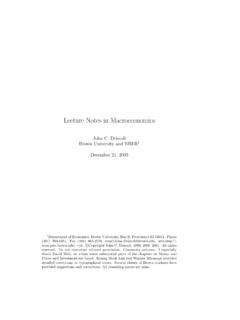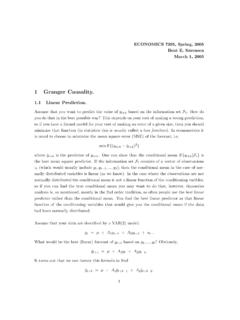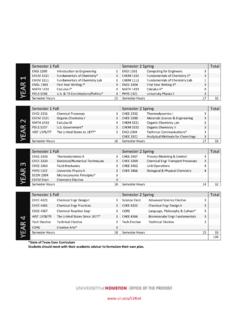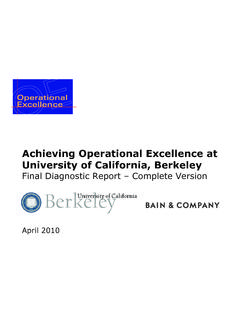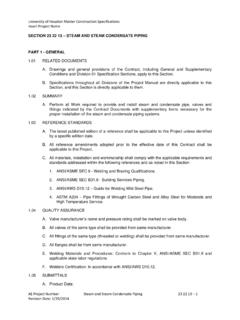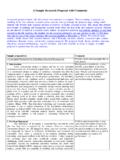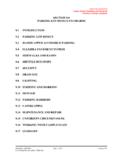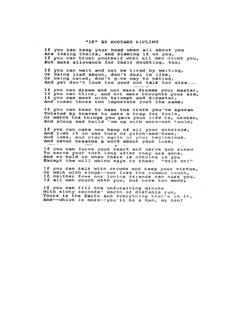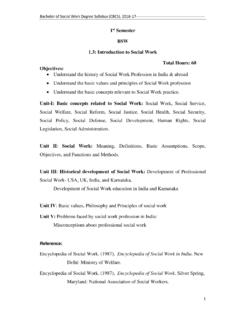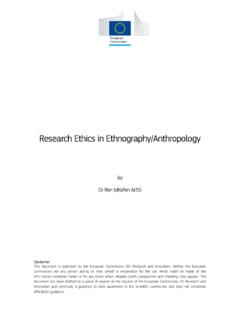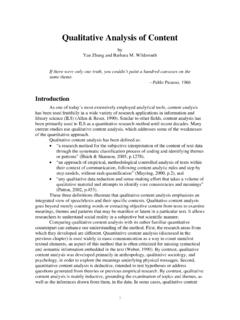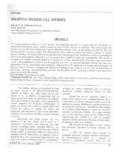Transcription of Why is the study of anthropology important to today’s …
1 Pearson is proud to announce the winners of the 2011 MEL EMBER STUDENT SchoLaRShiP coNTEST:Why is the study of anthropology important to today s world?Nate Stanley Texas State University FiRST PLacE Melissa Wrapp University of Notre Dame SEcoND PLacE Tiffany Davis University of houston ThiRD PLacE First PlaceNate StanleyTexas State University Nate s course work and research studies reveal his love of learning, interest in anthropology , and commitment to hard work. He is one of the finest students that I have ever worked with and is truly a credit to our university. Elizabeth M. Erhart, , Chair of the Department of anthropology and Associate Professor of anthropology , Texas State UniversityNate Stanley was born in South Dakota, and grew up most of his life in iowa.
2 Currently, he works at the center for archaeological Studies at Texas State University as an archaeologist and curator. he will be receiving his Bachelor of Science in anthropology , and certificate in Geographic Information Science (GIS), in May 2012 from Texas State University San Marcos. he has been accepted to Texas State University s Ma anthropology program, as well as SUNY Binghamton s MS Biomedical anthropology program, and is still in the process of deciding which to attend. his areas of interest are primate/rainforest conservation and human skeletal anatomy. hopefully, this summer he will be accompanying a candidate from the University of Texas San antonio to Naha, Mexico, to gain some very valuable field research , Thailand, Mexico, china. These are just a few of the countries i visited by the age of 18.
3 My parents taught English as a second language, and i have been fortunate to travel with them. During my travels i was exposed to fascinating cultures: the extravagant palaces and jungles of Thailand, the petroglyphs in azerbaijan, the shrine topped rolling hills of Mongolia. in every country i visited, a question developed in my mind: Why is this place so different? Not just different from where I was born, to different from any place I had visited before. Through my years in studying anthropology , i have been taught that anthropology is an interconnected discipline. Its subfields have the capability to use each other s research and methodology to explain the complexity that is the human condition. That is the strength within anthropology ; we are given the task of explaining phenomenon no other discipline can, or, sometimes, even wants to tackle.
4 Take the development of processual archaeology for example. Since it is near impossible to create a completely correct hypothesis or theory as to how past people lived, archaeologists have come up with ways to come to the nearest possible answer. Before processual archaeology, there was culture history. What culture history failed to do was really. it gave a subjective chronological sequence of cultural development based on the tools that have been excavated, but it did not explain behaviors of the culture itself; like why tools were used at some times and not others. Then, Lewis Binford introduces middle range theory by utilizing the ethnoarchaeological method to understand why only certain bones of caribou are found at kill sites. he does this by observing what modern alaskans do after they have killed a caribou; they take with them the parts of the body with the most meat, leaving behind more or less the same assemblage of caribou parts found in the archaeological record (skulls, lower legs, vertebra).
5 You can see how middle range theory goes beyond classifying culture. it explains the archaeological record as accurately as possible. carl Wissler, a cultural anthropologist who came up with the terms culture area and culture age , hypothesized that, if we consider all the traits available within a culture and focus on the social aspect of it, you get distinct social groups1 (204). In this way he believed you could classify societies by their cultural traits. changes in technology, for example, can be observed in different groups through time, radiating out of a cultural center 1 (204), which can be an indication of trade and/or migration. What about artifacts that didn t serve as tools, like with the old copper Complex? As examined by Lewis Binford, a tool needs to have as much or greater benefit in its use compared to the amount of energy that was needed to create it.
6 The energy exertion/consumption ratio didn t add up the way it should with copper tools. copper took longer to procure and it was often not found in areas where artifacts were deposited2 (221). Efficiency in use and manufacture both need to be factors to view a tool more useful than another, and chert was clearly the material that exhibited both. So why were copper tools showing up? Looking beyond the artifacts themselves can answer such a question. The artifacts were found in burials with no indication that the tools had been reused or worn out. Binford sees this phenomenon as a shift from the manufacture of tools used to survive to artifacts with symbolic meaning2 (221). With the appearance of non-tools with an unequal ratio of use and manufacture, an indicator of population expansion occurs, where certain individuals will require symbols of higher social rank.
7 Although merely a hypothesis, and the possibility that these socio-technic items served as technomic tools as well, Binford s systemic approach is the beginning of explanation that can be furthered as archaeologists continue to use all the data they have. The new archaeological methods of explanation are not confined to archaeology. The issue of climate change is one such example where anthropologists should be involved in understanding and explaining the relationship between humans and our environment. in the past, changes in climate affected ancient people to the extent that they had to relocate, utilize different technology, and sometimes change their diet. Such a change is happening today in alaska and canada. The indigenous people have begun to see drastic changes in weather patterns.
8 These patterns disrupt their hunting seasons, making hunting routes passed on through generations dangerous and at times impassable. Of course, with negative effects, there must be positive ones. And there are. in Kotzebue, alaska, natives are experiencing a surplus of fish and clam harvests, as well as drift wood and caribou because of the climate change3 (156). This impact is not positive for those living outside Kotzebue, where they experience rough terrain, thin ice, and the dangers of flooding. Through an anthropological view, this can lead to migration of people, or wiping out, over time, of certain populations. By understanding how the indigenous people of alaska and canada are affected by the change in climate, we can explain to others the best way to help them.
9 The goal of anthropology is to understand the human condition. The human condition includes what has happened in the past, what is happening now, and what will happen later on. again, the great thing about anthropology s subfields is that we can use each other s knowledge and research techniques to better understand why we act the way we do, and how it affects our physical, cultural, social , and political environments. This is how anthropology affects the world we live in. After all, it is easier to help others when you first understand them. 1 Wissler, clark and Weitzner, Bella. 1917. The American Indian: An Introduction to the anthropology of the New World. Douglas c. McMurtrie. New York. 7 Binford, Lewis R. 1962. Archaeology as anthropology . American Antiquity, Vol.
10 28, No. 2. Society for american archaeology. 217 henshaw, anne. 2009. Chapter 6 Sea Ice: The Sociocultural Dimensions of a Melting Environment in the Arctic. anthropology and climate change: From Encounters to actions. Left coast Press. Walnut creek, ca. 153 : An Explanatory Method to Understand Our WorldBy Nate Stanley I cannot speak highly enough about Melissa s abilities as an intellectual and her character as a person. Her writing is brilliant far above her classmates and indeed even beyond many graduate students. Dr. Catherine Bolten, Assistant Professor, anthropology and Peace Studies, University of Notre DameMelissa Wrapp is a senior pursuing a degree in anthropology and International Peace Studies, with a certificate in International Business, at the University of Notre Dame.
